I'm trying to plot a pandas series, but I'm encountering an error when I attempt to format the x-axis date.
(A related issue was identified in the comments, but it appears that it was resolved in a much older version of pandas than what I'm using. So, it seems like this is a new problem.)
Consider a plot of the following pandas series:
import pandas as pd
d = {pd.Timestamp('2021-03-15 08:30:00'): -65.926651,
pd.Timestamp('2021-03-15 08:30:05'): -42.115551,
pd.Timestamp('2021-03-15 08:30:10'): -24.699627,
pd.Timestamp('2021-03-15 08:30:15'): -12.010081,
pd.Timestamp('2021-03-15 08:30:20'): -2.781321}
s = pd.Series(d)
ax = s.plot()
I seek to format the x-axis date on the plot using:
from matplotlib.dates import DateFormatter
format_str: str = '%H:%M:%S'
format_: DateFormatter = DateFormatter(format_str)
ax.xaxis.set_major_formatter(format_)
This results in the following error:
Traceback (most recent call last):
File "/Users/me/VirtualEnvironments/my_venv/lib/python3.9/site-packages/matplotlib/backends/backend_macosx.py", line 61, in _draw
self.figure.draw(renderer)
File "/Users/me/VirtualEnvironments/my_venv/lib/python3.9/site-packages/matplotlib/artist.py", line 41, in draw_wrapper
return draw(artist, renderer, *args, **kwargs)
File "/Users/me/VirtualEnvironments/my_venv/lib/python3.9/site-packages/matplotlib/figure.py", line 1863, in draw
mimage._draw_list_compositing_images(
File "/Users/me/VirtualEnvironments/my_venv/lib/python3.9/site-packages/matplotlib/image.py", line 131, in _draw_list_compositing_images
a.draw(renderer)
File "/Users/me/VirtualEnvironments/my_venv/lib/python3.9/site-packages/matplotlib/artist.py", line 41, in draw_wrapper
return draw(artist, renderer, *args, **kwargs)
File "/Users/me/VirtualEnvironments/my_venv/lib/python3.9/site-packages/matplotlib/cbook/deprecation.py", line 411, in wrapper
return func(*inner_args, **inner_kwargs)
File "/Users/me/VirtualEnvironments/my_venv/lib/python3.9/site-packages/matplotlib/axes/_base.py", line 2747, in draw
mimage._draw_list_compositing_images(renderer, self, artists)
File "/Users/me/VirtualEnvironments/my_venv/lib/python3.9/site-packages/matplotlib/image.py", line 131, in _draw_list_compositing_images
a.draw(renderer)
File "/Users/me/VirtualEnvironments/my_venv/lib/python3.9/site-packages/matplotlib/artist.py", line 41, in draw_wrapper
return draw(artist, renderer, *args, **kwargs)
File "/Users/me/VirtualEnvironments/my_venv/lib/python3.9/site-packages/matplotlib/axis.py", line 1164, in draw
ticks_to_draw = self._update_ticks()
File "/Users/me/VirtualEnvironments/my_venv/lib/python3.9/site-packages/matplotlib/axis.py", line 1022, in _update_ticks
major_labels = self.major.formatter.format_ticks(major_locs)
File "/Users/me/VirtualEnvironments/my_venv/lib/python3.9/site-packages/matplotlib/ticker.py", line 250, in format_ticks
return [self(value, i) for i, value in enumerate(values)]
File "/Users/me/VirtualEnvironments/my_venv/lib/python3.9/site-packages/matplotlib/ticker.py", line 250, in <listcomp>
return [self(value, i) for i, value in enumerate(values)]
File "/Users/me/VirtualEnvironments/my_venv/lib/python3.9/site-packages/matplotlib/dates.py", line 605, in __call__
return num2date(x, self.tz).strftime(self.fmt)
File "/Users/me/VirtualEnvironments/my_venv/lib/python3.9/site-packages/matplotlib/dates.py", line 511, in num2date
return _from_ordinalf_np_vectorized(x, tz).tolist()
File "/Users/me/VirtualEnvironments/my_venv/lib/python3.9/site-packages/numpy/lib/function_base.py", line 2108, in __call__
return self._vectorize_call(func=func, args=vargs)
File "/Users/me/VirtualEnvironments/my_venv/lib/python3.9/site-packages/numpy/lib/function_base.py", line 2192, in _vectorize_call
outputs = ufunc(*inputs)
File "/Users/me/VirtualEnvironments/my_venv/lib/python3.9/site-packages/matplotlib/dates.py", line 331, in _from_ordinalf
np.timedelta64(int(np.round(x * MUSECONDS_PER_DAY)), 'us'))
OverflowError: int too big to convert
Interestingly, if I add a fractional offset to the timestamps, everything works:
s.index += pd.DateOffset(seconds=0.5)
When I examine x in the np.timedelta64 call, it corresponds to the number of days since the start of the unix epoch (1 Jan 1970) only if I add a fractional part to the timestamp. If there's no fractional part, the resulting integer is huge and seems to have no obvious relationship to the number of days since 1 Jan 1970.
What's wrong here?
